Boeing P-26 Peashooter
The Boeing P-26 "Peashooter" was the first American all-metal production fighter aircraft and the first pursuit monoplane to enter squadron service with the United States Army Air Corps. Designed and built by Boeing, the prototype first flew in 1932, and the type was still in use with the U.S. Army Air Corps as late as 1941 in the Philippines. There are only two surviving Peashooters, but there are three reproductions on exhibit with two more under construction.
| P-26 "Peashooter" | |
|---|---|
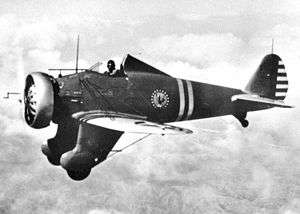 | |
| P-26 Peashooter in flight | |
| Role | Fighter |
| National origin | United States |
| Manufacturer | Boeing |
| First flight | 20 March 1932 |
| Retired | 1956 (Guatemala)[1] |
| Primary users | United States Army Air Corps Republic of China Air Force Philippine Army Air Corps Guatemalan Air Force |
| Number built | 151[2] |
| Unit cost |
$14,009[3] |
| Variants | Boeing P-29/XF7B-1 |
Design and development
The project, funded by Boeing, to produce the Boeing Model 248 began in September 1931, with the US Army Air Corps supplying the engines and the instruments. The design, which included an open cockpit, fixed landing gear and externally braced wings, was the last such design procured by the USAAC as a fighter aircraft. The Model 248 had a high landing speed, which caused a number of accidents. To remedy this, flaps were fitted to reduce the landing speed. The Army Air Corps ordered three prototypes, designated XP-936, with the first flight on 20 March 1932.
The Boeing XP-936 was still tricky to land and could roll onto its back while landing, injuring the pilot. The prototype's headrest offered little protection in such instances. As a result, production Model 266s (P-26As) had a taller headrest installed to provide some protection.
Two fighters were completed as P-26Bs with fuel-injected Pratt & Whitney R-1340-33 engines. These were followed by twenty-three P-26Cs, with carburated R-1340-33s and modified fuel systems. Both the Spanish Air Force (one aircraft) and the Republic of China Air Force (eleven aircraft) ordered examples of the Boeing Model 281, an export version of the P-26 comparable to the P-26C, in 1936.
The diminutive "Peashooter", as it was known by service pilots, was faster than previous American combat aircraft. Nonetheless, rapid progress in aviation led to it quickly becoming an anachronism, with wire-braced wings, fixed landing gear and an open cockpit. The stressed-skin cantilever-wing Dewoitine D.500 flew the same year as the P-26 and two years afterwards the Soviet I-16 was flying with retractable landing gear. By 1935, just three years after the P-26, the Curtiss P-36, Messerschmitt Bf 109 and Hawker Hurricane were all flying with enclosed cockpits, retractable landing gear and cantilever wings. However, the P-26 remained in service until after the United States entered World War II in December 1941.
Operational history
U.S. Army Air Corps
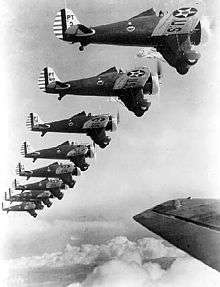
Deliveries to USAAC pursuit squadrons began in December 1933 with the last production P-26C aircraft coming off the assembly line in 1936. Ultimately, 22 squadrons flew the Peashooter, with peak service being six squadrons, in 1936. P-26s were the frontline fighters of the USAAC until 1938, when Seversky P-35s and Curtiss P-36s began to replace the P-26. A total of twenty P-26s were lost in accidents between 1934 and America's entry into World War II on 7 December 1941, but only five before 1940.
Air Corps units using the P-26[4] were the:
- 1st Pursuit Group (17th, 27th, and 94th PS), Selfridge Field, Michigan;
- 4th Composite Group (3d, 17th, and 20th PS), Nichols and Clark fields, Philippine Department.
- 8th Pursuit Group (33rd, 35th, and 36th PS), Langley Field, Virginia;
- 16th Pursuit Group (24th and 78th PS), Albrook Field, Panama Canal Zone;
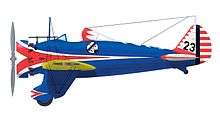
Overseas deployments
Between 1938 and 1940, P-26s were assigned overseas to supplement Seversky P-35s in two defense units based at Wheeler Field, Territory of Hawaii:
- 18th Pursuit Group (6th, 19th, 73d, and 78th PS)
- 15th Pursuit Group (45th and 47th PS).
The 17th PG became the 17th Attack Group in 1935, and its P-26s were transferred in 1938 to the 16th Pursuit Group (24th, 29th, and 78th PS) at Albrook Field in the Panama Canal Zone. These P-26s were transferred in 1940 to the 37th Pursuit Group (28th, 30th, and 31st PS) which flew them until they were replaced by P-40s in May 1941. Some continued service with the 32d Pursuit Group (51st and 53rd PS), but only nine P-26s remained operational in Central America at the start of World War II.
P-26As were also flown by the 3d PS of the 4th Composite Group, based in the Philippines. Between 1937 and 1941, 31 were sold to the fledgling Philippine Army Air Corps.
Combat service
The first Boeing P-26 to experience major combat operation was the Chinese Model 281. On 15 August 1937, eight P-26/281s from the Chinese Nationalist Air Force 3rd Pursuit Group, 17th Squadron, based at Chuyung airfield, engaged eight out of twenty Mitsubishi G3M Nell medium bombers from the Kisarazu Air Group sent to attack Nanking. The Chinese Boeing fighters helped shoot down two of the four Japanese bombers destroyed that day without suffering any losses. Subsequent engagements between the Chinese Peashooter pilots and pilots of the Imperial Japanese Navy flying the Mitsubishi A5M (Allied reporting name "Claude") were the first aerial dogfights and kills between all-metal monoplane fighter aircraft.[5] A single P-26 was in service with the Spanish Republican Air Force during the Spanish Civil War of 1936–1939, but no aerial kills were recorded with it before it was shot down in 1936.[6][7]
By December 1941, U.S. fighter strength in the Philippines included 28 P-26s, 12 of which were operational with the 6th Pursuit Squadron of the Philippine Army Air Corps.[8] In the skies above Zablan and Batangas Fields, Captain Jesus A. Villamor flew against Japanese Zeros, his squadron of Boeing P-26 Peashooter fighters engaged the enemy. Despite the disadvantage, Villamor and his squadron was credited with four kills – one Mitsubishi G3M bomber and three Mitsubishi A6M Zeros. Two of them by Villamor himself.[9] For leading his squadron and for his two confirmed kills, Villamor was twice cited by the United States Army for bravery, receiving the Distinguished Service Cross for actions on December 10, 1941 and an Oak Leaf Cluster in lieu of a second award of the Distinguished Service Cross (DSC) for actions on December 12, 1941.[10][11] The P-26s were burned by their crews to prevent capture by advancing Imperial Japanese Army forces on 24 December 1941.[12]
Only nine P-26s remained airworthy, serving with the United States Army Air Forces (as the USAAC had been renamed in June 1941) in the Panama Canal Zone. In 1942–1943, the Guatemalan Air Force acquired seven P-26s, which the United States Government delivered to Guatemala as "Boeing PT-26A" trainers to get around restrictions on sales to Latin American countries.[13] The last two P-26s in service in the world were still flying with the Guatemalan Air Force in 1956, when they were replaced with P-51 Mustangs. The P-26's last combat operation was with the Guatemalan Air Force during a coup d'état in 1954.[14]
Although Boeing produced the prototype XF8B in 1944 and the X-32 entry in the Joint Strike Fighter contest in 2000, the P-26 was the last Boeing Company fighter aircraft to enter service until Boeing acquired McDonnell-Douglas and took over its production and continuing support contracts for the Boeing F/A-18E/F Super Hornet in 2002.
Variants
- XP-936
- Three prototype aircraft for the U.S. Army Air Corps, powered by 525 hp (391 kW) Pratt & Whitney R-1340-21 Wasp radial engines. First flight: 20 March 1932.
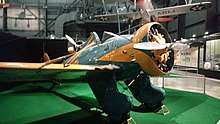
- P-26A
- Single-seat fighter aircraft, powered by a 600 hp (450 kW) R-1340-27; 111 built.
- P-26B
- Single-seat fighter, powered by a fuel-injected 600 hp (450 kW) R-1340-33; two built.
- P-26C
- Single-seat fighter, with a carburated R-1340-33 and a modified fuel system; 23 built.
- Model 281
- Export version of the P-26C; 11 built for China, one built for Spain, 12 built.
Operators
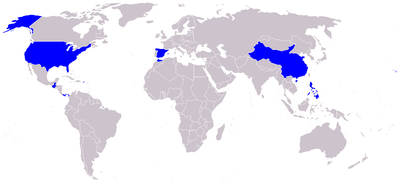
- Chinese Nationalist Air Force – (Nationalist China, 1930s)
- Guatemalan Air Force – (Until 1957)
- Philippine Army Air Corps – (until the end of 1941)
- Spanish Republican Air Force – (1 demonstrator used briefly)
- U.S. Army Air Corps
Surviving aircraft

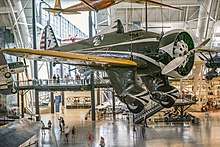
- P-26A c/n 1899 serial number 33-123 is currently{[when}} on display at the Planes of Fame Museum in Chino, California. This aircraft was sold to the Guatemalan Air Force on 11 May 1943, and it flew as FAG 0672 until it was retired in 1957 when it was recovered by Ed Maloney. Once flown regularly with the registration N3378G, the museum's P-26 was placed on static display in the mid-1980s to protect it. In 2004, the decision was made to again fly the P-26, and a restoration was begun to return the P-26 to flying condition. This was completed in the spring of 2006, with the aircraft making its first appearances during the museum's air show in May 2006.[15] The aircraft was transported across the Atlantic and flown and displayed at Duxford Aerodrome in England in July 2014 during the type's first post-World War II visit to Europe.
- P-26A c/n 1911 serial number 33-135 is in the collection of the Smithsonian Institution′s National Air and Space Museum. This aircraft was originally assigned to the 94th Pursuit Squadron at Selfridge Field, Michigan, and it was one of the P-26As sent to the Panama Canal Zone. It was sold to the Guatemalan Air Force on 11 May 1943, and it was flown as FAG 0816 until it was retired in 1957. It then was donated to the Smithsonian Institution. This aircraft was restored by the [United States Air Force]], and it was on display at the National Museum of the United States Air Force in the markings of the 34th Attack Squadron through 1975, when it was returned for display at the National Air and Space Museum, which opened in Washington, D.C., in 1976.
Replicas
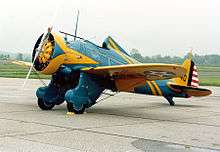
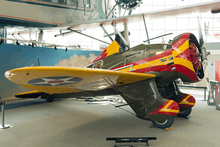
- A P-26A reproduction is on display at the National Museum of the United States Air Force at Wright-Patterson AFB in Dayton, Ohio.[16] It is painted as the commander's aircraft of the 19th PS / 18th PG, stationed at Wheeler Field, Oahu, Territory of Hawaii, in 1938.
- The San Diego Air and Space Museum has made a reproduction of an early model to Boeing's plans with the original design's "streamlined tailwheel" and without flaps and the crossover exhaust that were later additions. [17]
- P-26D: A flying replica completed in 2006 is in the collection of the Military Aviation Museum, Virginia Beach, Virginia. </ref> Mayocraft Inc., completed the final assembly in September 2006, and it went on display in June, 2011 after nearly 12 years of construction.[18] Retrieved: 17 March 2007.[19]
- P-26A: Two flyable reproduction aircraft using original blueprints are currently being constructed by Golden Age Aeroplane Works, LLC in Brownstown, Indiana.[20]
Specifications (P-26A)
Data from Aviation-history.com[21]
General characteristics
- Crew: 1
- Length: 23 ft 7 in (7.19 m)
- Wingspan: 28 ft (8.5 m)
- Height: 10 ft (3.0 m)
- Airfoil: Boeing 109[22]
- Empty weight: 2,196 lb (996 kg)
- Gross weight: 3,360 lb (1,524 kg)
- Powerplant: 1 × Pratt & Whitney R-1340-27 Wasp 9-cylinder air-cooled radial piston engine, 600 hp (450 kW)
- Propellers: 2-bladed fixed-pitch propeller
Performance
- Maximum speed: 234 mph (377 km/h, 203 kn)
- Combat range: 360 mi (580 km, 310 nmi)
- Ferry range: 635 mi (1,022 km, 552 nmi)
- Service ceiling: 27,400 ft (8,400 m)
- Rate of climb: 719 ft/min (3.65 m/s)
Armament
- Guns: 2 × .30 in (7.62 mm) M1919 Browning machine guns or 1 x .30 (7.62 mm) and 1 x .50 (12.7 mm) caliber machine guns
- Bombs: 2 × 100 lb (45 kg) GP bombs or 5 x 31 lb (14 kg) anti-personnel bombs [23]
See also
Aircraft of comparable role, configuration and era
Related lists
References
Notes
Citations
- Maloney 1973, p. 47.
- Bowers 1976, p. 24.
- Bowers 1976, p. 20.
- Maloney and Ryan 1965, Squadron Assignments
- Gustavsson, Håkan. "Sino-Japanese Air War 1937–1945." surfcity.kund.dalnet.se, 14 April 2010. Retrieved: 5 August 2010.
- Nash, David. "Aircraft that took part in the Spanish Civil War." Aircraft of the Spanish Civil War, 31 March 2008. Retrieved: 5 August 2010.
- Green and Swanborough Air Enthusiast December 1980 – March 1981, p. 73.
- Shores, Cull and Izawa 1992, p. 56.
- John Toland (17 August 2016). But Not in Shame: The Six Months After Pearl Harbor. Random House Publishing Group. pp. 110–113. ISBN 978-1-101-96929-8.
- "Jesus A. Villamor". Hall of Valor, Military Times. Gannett Government Media Corporation. Retrieved 17 January 2013.
- "Roll of Honor". Times. Times Inc. 12 (7): 57. 1942. ISSN 0024-3019. Retrieved 17 January 2013.
- Shores, Cull and Izawa 1992, pp. 184–185, 195.
- Baugher, Joe. "Boeing P-26". USAAC/USAAF/USAF Fighter and Pursuit Aircraft: Original Fighter Series-1922 to 1962. Retrieved: 5 August 2010.
- Cooper, Tom. "Guatemala since 1954." Central and Latin American Database, 1 September 2003. Retrieved: 5 August 2010.
- "Photo 33-123 (airliners photo collection)." airliners.net. Retrieved: 5 August 2010.
- "P-26 Peashooter." Archived December 26, 2007, at the Wayback Machine National Museum of the United States Air Force. Retrieved: 5 August 2010.
- ""Peashooter" fighter goes on display in San Diego" San Diego Union-Tribune. Retrieved: 30 March 2015.
- "P-26 Projects." Mayocraft.
- "P-26 Peashooter." Military Aviation Museum. Retrieved: 31 May 2013.
- O'Connor, Tim. "Golden Age P-26 Page." Golden Age Aeroplane Works,LLC. Retrieved: 26 July 2017.
- "Boeing P-26 Peashooter". www.aviation-history.com. The Aviation Internet Group. 2002. Retrieved 25 February 2020.
- Lednicer, David. "The Incomplete Guide to Airfoil Usage". m-selig.ae.illinois.edu. Retrieved 16 April 2019.
- Fitzsimons 1978, pp. 2062–2063.
Bibliography
- Angelucci, Enzo and Peter M. Bowers. The American Fighter. Sparkford, Somerset, UK: Haynes Publishing Group, 1987. ISBN 0-85429-635-2.
- Bowers, Peter M. Boeing Aircraft since 1916. Annapolis, Maryland: Naval Institute Press, 1989. ISBN 0-85177-804-6.
- Bowers, Peter M. Boeing P-26 Variants (Aerofax Minigraph 8). Arlington, Texas: Aerofax Inc., 1985. ISBN 0-942548-13-2.
- Bowers, Peter M. "The Boeing P-26A". Aircraft in Profile, Volume One, Part 2. Windsor, UK/Garden City, NY: Profile Publications/Doubleday, revised 4th edition, 1976. ISBN 0-85383-411-3.
- Crosby, Francis. "Boeing P-26." Fighter Aircraft. London: Lorenz Books, 2002. ISBN 0-7548-0990-0.
- Davis, Larry. P-26 (Mini in Action number 2). Carrollton, Texas: Squadron/Signal Publications Inc., 1994. ISBN 0-89747-322-1.
- Dorr, Robert F. "Boeing P-26 Peashooter". Air International, Vol. 48, No. 4, 1995, p. 239.
- Fitzsimons, Bernard, ed. The Illustrated Encyclopedia of 20th Century Weapons and Warfare (Volume 19). London: Purnell & Son Ltd, 1978, First edition 1971. No ISBN.
- Green, William and Gordon Swanborough. "Boeing's Fighter Finale... The Peashooter Chronicle". Air Enthusiast, Fourteen, December 1980 – March 1981, pp. 1–12, 73–75.
- Maloney, Edward T. Boeing P-26 "Peashooter" (Aero Series 22). Fallbrook, California: Aero Publishers Inc., 1973. ISBN 0-8168-0584-9.
- Maloney, Edward T. and Frank Ryan. P-26: History of the Famous Boeing P-26 "Peashooter" (Air Museum Historical Series). Hollywood, California: Challenge Publications, Inc., 1965.
- Pedigree of Champions: Boeing Since 1916, Third Edition. Seattle, Washington: The Boeing Company, 1969.
- Shores, Christopher, Brian Cull and Yasuho Izawa. Bloody Shambles: Volume one: The Drift to War to the Fall of Singapore. London: Grub Street, 1992. ISBN 0-948817-50-X.
- Wagner, Ray. American Combat Planes – Second Edition. Garden City, New York: Doubleday and Company, 1968. ISBN 0-370-00094-3.
External links
| Wikimedia Commons has media related to Boeing P-26 Peashooter. |